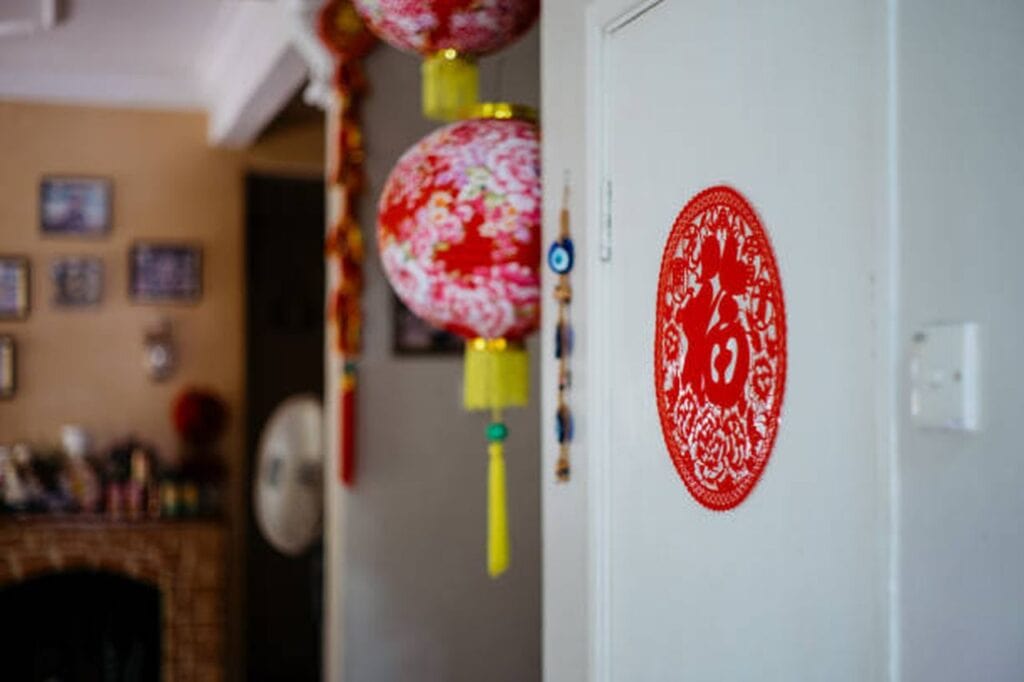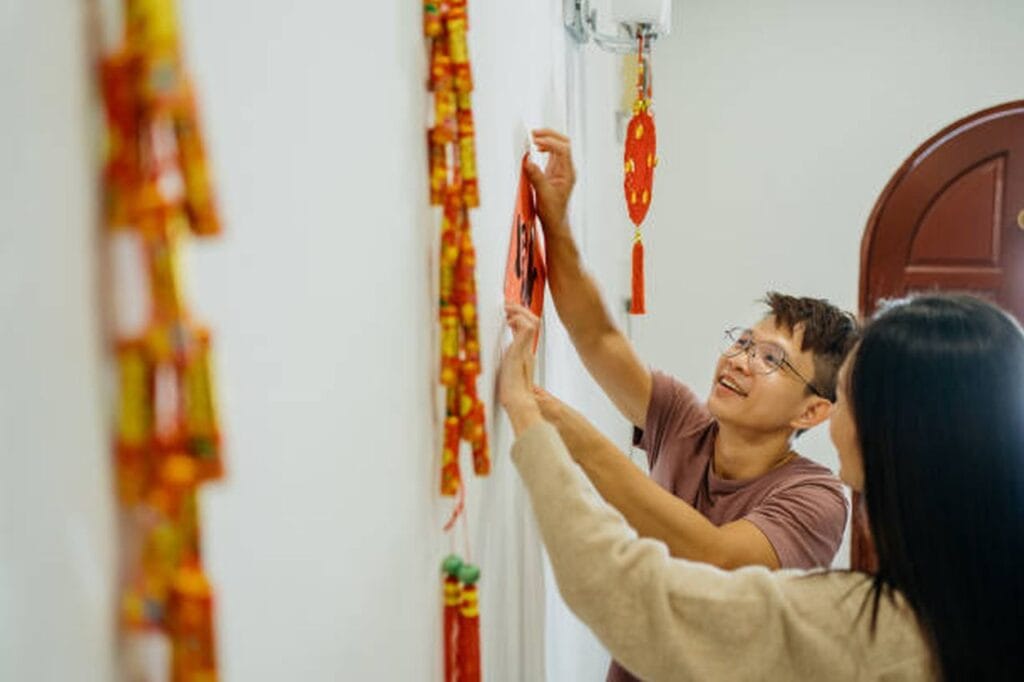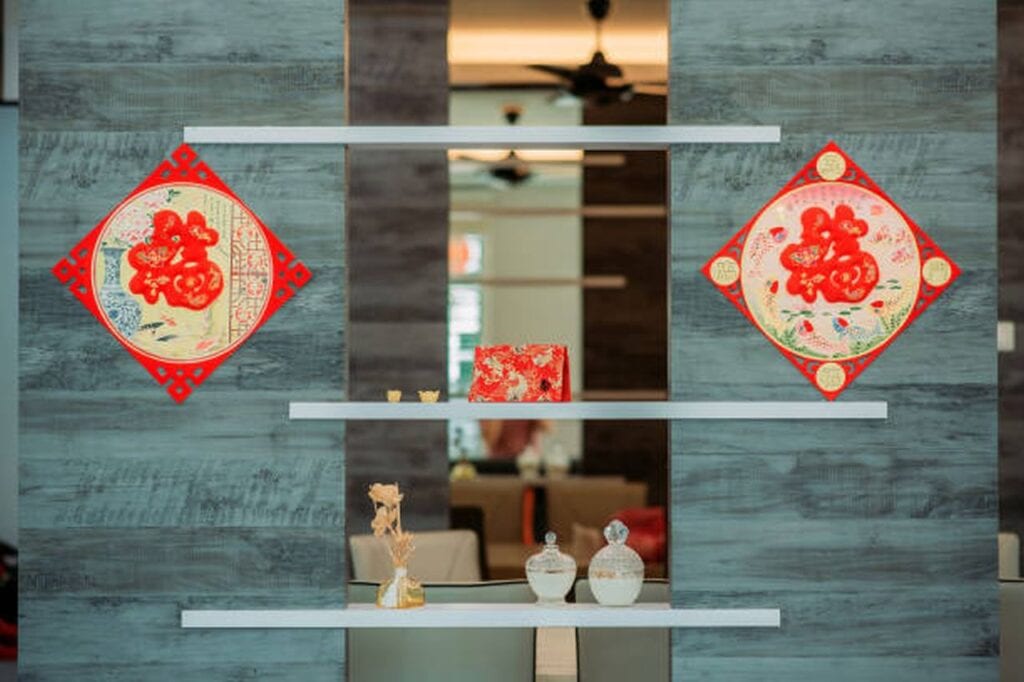A large majority of the Chinese individuals We know have some means of sprinkling their houses with cultural artefacts, whether in the form of large pieces of furniture or more little ones like vases or figurines. As a result, it is not uncommon to see living rooms with some sort of Chinese influence, which may be subtle or blatant.
Images of beautiful Chinese-inspired living spaces follow. The designer and decorator merely made it a great vibe, but the decorations and furnishings on this list are extremely familiar and fairly typical. All of these pictures have an Asian flavour that will make you wish you could visit places where people are as culturally rich as the Chinese. Get ready for an incredible compilation.
Asian Chic
The peaceful atmosphere of a family meeting area is enhanced with Asian-inspired details. Take note of the abundance of wood, stone, and other natural elements.
Asian Influence
With a few Asian touches to make it feel more at home, this family room is beautiful in the traditional sense that an Asian living room would be.
Eclectic Living Room In Burlington
Large sash windows, high ceilings, and abundance of natural light make the interior, which has a modernist lean, perfect for displaying Ciambra's artwork. We change the artwork on the walls frequently because we get bored of it.
Diamond Head Renovation
Another spare space with nothing to really look at save for some plants in bright red containers and some Asian-inspired art.
Eclectic Asian Fusion
Take a peek at the cool screen hiding behind the red sofa; it features a miniature Chinese setting. However, the carpet is beautiful.
Great Falls, Virginia Home
By including wooden accents and furnishings, you may achieve a fusion of styles between the modern sofa and the more traditional Asian aesthetic.
Hanalei Bay Vista Estate
Stunning tropical contemporary mansion with an Asian theme, set on a bluff over Hanalei Bay.
Hawaiian Retreat
Fantastic looking family room; the presence of doors is a nice touch. We really like the TV stand.
Makena Residence
Instead of white, this calming green has undertones of wheat and medium wood.
Marin
The utilisation of a number of different vintage Chinese pieces to create an Asian-themed space really brought the whole area together.
Chinese lanterns
The most important Chinese events, such as the Spring Festival and Mid-Autumn Festival, are when crimson lanterns (燈籠) are employed. These lanterns are not as common during Chinese New Year, but you may still see them hanging in front of stores and homes. To dispel sadness and welcome good fortune, Chinese lanterns are traditionally strung up indoors. Thus, you can expect to see these everywhere in the city during Chinese New Year.
Chinese firecrackers
During the Chinese New Year, you may see lots of businesses with displays of Chinese firecrackers (炮仗) in front of them. These explosive fireworks are a symbol of joy and celebration, as they herald in the new year with a bang. They are traditionally lit in front of homes and businesses to scare away ghosts and other evil spirits with the sounds they make.
Paper cuttings
Red paper is used to create intricate patterns that are then attached on windows and other see-through surfaces. Designs often feature colourful Chinese characters and imagery like mandarins, kumquats, and the corresponding zodiac animal for the year. Many of the symbols of longevity, honour, money, and success may be found among the characters, fruits, and animals.
Door couplets
These bright red and gold banners carry wishes of success, wealth, health, and good fortune. Although door couplets are most commonly found indoors, such as in the living room, they are also frequently seen outside, often at the entryway to buildings such as residences, stores, schools, and other enterprises.
Upside Down Fuk (福)
Pronounced fook, the letter fuk denotes success. When turned upside down, the symbolism signifies good fortune is being showered onto the user. The symbol is typically displayed at the front doors of homes and businesses, written in a diamond shape on a piece of red paper. Now is the time to prepare for a flood of good fortune to enter your life.
Red Packets
Red packets (利是) are the most beloved Chinese New Year decorations, and for good reason: they hold money. As a symbol of good fortune and prosperity, red packets are commonly used to transfer money from newlyweds to younger relatives. In addition, you can find crimson packets, symbols of riches, draped from kumquat, orange, and mandarin trees.
Mandarin, Orange, And Kumquat Trees
Gum gut is the phonetic transcription of the Cantonese word for kumquat (柑桔). The Chinese words for "gold" (金) and "good luck" (吉) are pronounced identically to these two characters. Many people plant kumquat, orange, or mandarin trees outside their homes on Chinese New Year's Day in the hopes of attracting financial success and good fortune into their lives.
Orchids, Cherry Flowers, And Plum Blossoms
The first flowers to emerge after a long winter are the fragile ones, including cherry blossoms, plum blooms, and orchids. Thus, they represent the arrival of spring, the rebirth of life, and a fresh start, all of which are fundamental to the Chinese New Year's celebrations. In addition, the lengthy stems of these blooms represent prosperity and life. Because of these reasons, Chinese New Year celebrations often feature floral arrangements.

Spring Festival Couplets
Various Couplets for the Spring Festival It's time for the Spring Festival! During the holiday season, couplets (also known as door couplets) are used to send New Year's greetings and wishes by pasting them on both sides of the door. Typically, they are written in black ink on red paper, making them stand out and looking very classy. There should be symmetry and order in the construction of the couplets' sentences. When it comes to the substance, New Year's greetings are where most people opt to share their best hopes and intentions for the next year. The couplets of some families can be quite illuminating because they often reveal the family's philosophy on what constitutes a happy life. Beginning in the Song Dynasty (960–1279), this practice gained widespread acclaim during the Ming Dynasty (1368–1644) and has persisted to the present day.
Fu Characters And New Year Paintings
Fu ideograph New Year paintings and Fu characters are traditional Chinese New Year decorations. The Chinese character Fu is commonly used around the New Year because it represents blessing and good fortune. The reason it's usually pasted upside down on a door or window is that the Chinese word for inversion is "dao," which sounds identical to the word for "coming" in Mandarin. So, if you see an upside-down Fu figure, it portends a happy ending.
There is a wide range of subjects shown in New Year's paintings, from gods of mythology to godlike mythical figures said to bring good fortune in the next year. Most commonly seen are depictions of the Door God, who is believed to protect the home, and the God of Wealth, who is believed to provide financial success to the household.
Chinese Knots
The Chinese knot is a centuries-old art form. Knots were originally employed for simple recording purposes, but over time they've evolved into fashionable ornaments. The majority of their time is spent as ornaments on display or as presents for loved ones. It is also one of the most often used symbols of the Chinese New Year. Typically, a single rope is used to tie a Chinese knot, although multiple simple knots can be combined to make more complex knots. The names of the many various types of knots all have something to do with the concepts of "safety" and "auspiciousness," even if their shapes themselves indicate something entirely different. Because of its meaningful design and aesthetic appeal, it is widely used to decorate homes for the Chinese New Year.
Paper Cuttings
Paper-cutting Window Trim Paper cuttings, another common sight at Chinese New Year celebrations, are considered an art form in its own right. People's hopes for the future are represented by the paper cuttings, which are then glued on windows, doors, or walls. Paper cuttings typically include the New Year's zodiac animal or one of the four lucky characters (Fu, Lu, Shou, and Xi) that bring good fortune, riches, and joy. You can also incorporate some interesting legends and lucky plants into your New Year paper cuts.
Chinese Red Lanterns — Drive Off Bad Luck
The Spring Festival is one of the most celebrated holidays in China and is often accompanied by the lighting of traditional paper lanterns. Festivals from the Chinese New Year to the Mid-Autumn Festival and the Lantern Festival.
Lanterns are a popular sight throughout Chinese New Year, adorning trees, buildings, and front doors everywhere from neighbourhoods to major cities. If you want to ward off misfortune, hang a red lantern by the door.
Door Couplets — Best Wishes For The Coming Year
Couplets are a common form of New Year's greeting in China since even numbers are considered lucky and auspicious. Chinese couplets are black ink brush works on red paper.
The couplet, which consists of two lines of seven (or nine) characters each, is typically displayed on either side of a door. Springtime has inspired a great deal of poetry. Some of the signs express the hopes and ideals of the community members, such as peace and success. It's possible that they'll stay up until the following Chinese New Year, at which point they'll be replaced.
Paper Cuttings — Luck And Happiness
Paper cutting is the practice of creating decorative pieces by cutting patterns out of paper (of any colour, though red is traditional during the Spring Festival) and adhering them to a background of a contrasting colour or a see-through surface (e.g. a window). Northern and central Chinese residents, for instance, often use red paper cuttings to decorate their homes' entrances and exits.
Many New Year's paper cutting projects take their inspiration from attractive flora and fauna depictions. However, each species of animal and plant stands for a unique need.
The peach, for instance, represents long life; the pomegranate, fruitfulness; the mandarin duck, love; the pine tree, youth without end; the peony, esteem and prosperity; and a magpie perched on the branch of a plum tree, good fortune.
New Year Paintings — A Symbol Of New Year’s Greetings
During the New Year, New Year Paintings ( niánhuà /nylon-hwaa/) are used as both a decorative accent and a symbol of good wishes. The paintings depict mythological figures and plants said to bring good fortune.
Upside-Down Fu Characters — Luck ‘poured Out’
Large diamonds (squares at 45°) of paper calligraphy featuring the inverted Chinese character (f /foo/) are pasted on or above doors alongside New Year couplets and, on occasion, paper cuttings.
There is an intentional switch of the fu characters. Posting the character for "fu," which can indicate "good fortune," in an inverted position conveys the sentiment that the poster desires that good fortune "spill forth" upon them.
Blooming Flowers — Wishes For A Prosperous New Year
The arrival of spring is celebrated as the Chinese New Year begins. As a result, it's usual practise to adorn homes with flowering plants as a way to welcome the approach of spring and express hopes for a fruitful new year.
Plum blossom branches, orchid stems, peony flowers, and peach flower stems are some of the most common types of flowering plants used in this context.
Decorations made of plants and flowers for Chinese New Year are very common in Hong Kong and Macau.
Feng Shui Home Decorations For The Chinese New Year
Whoever celebrates Chinese New Year is responsible for decorating the northeastern and northern sections of the home with white and dazzling decorations. Decorating the main room with red ornaments and colourful paper lanterns for Chinese New Year is also a good idea.
Avoid hanging garlands above the mirror after Chinese New Year, as this is considered bad Feng Shui. Put away any New Year's decorations that can disturb your sleep. A lack of energy is common throughout the Christmas season, and it may be exacerbated by the presence of ornaments near or over your bed. Specifically (Feng Shui bedroom design)
Feng shui advocates for the use of circular or oval dining tables, especially for important occasions like holidays. If your dining room table is square or rectangular, you can Feng Shui by writing the infinity symbol (an inverted horizontal number eight) on the surface with chalk and then covering the table with a white tablecloth for the holidays. Colours have symbolic implications in Feng Shui that can be incorporated into interior design.

Holiday Tables Centrepieces For Chinese New Year Celebrations
It's important to have the Chinese New Year meal in the dining room since it sets the tone for the entire event.
White and gold tones look elegant and festive on the Chinese New Year table. Feng shui and awe-inspiring interior design can be achieved with the help of red, white, and gold Chinese decorations and holiday table centrepieces. According to Chinese Feng Shui experts, using these refined hues can help the celebration of Chinese New Year last longer and invite an infusion of positive energy into your home. (Feng Shui colour palettes for the Year of the Rabbit)
Pine or fir branches, as well as tangerines, make for a festive centrepiece when used in vases during Chinese New Year. Asian influences can be seen in the holiday decorations through the use of vibrant orange and green colours found in branches and fruits.
Wonderful holiday tables, centrepieces, and delicious decorations can be constructed with homemade cakes, traditional spring flowers, and natural perfumes from China. (Creative floral centrepieces, novel presents, etc.)
Candles, flowers, and fruit can be used to create a wide variety of table centrepieces for the Chinese New Year. To produce a mild oriental smell for a Chinese New Year party, you may, for instance, set a candle in a clear bowl and fill the bowl with juniper berries and spicy cinnamon sticks.
Imagine something. Lengthy pine needles can be used as a centrepiece for the dinner table. A modern and trendy table centrepiece is a strand of pearl beads or a string of red beads strung on a few needles and placed on the table.
A traditional money tree can also be used to make lovely table centrepieces for lunar New Year celebrations. Rice, dried fruits, and fresh flower petals in a glass vase make for a lovely centrepiece.
Cypress or pine branches in glass vases packed with copper coins make for interesting and significant Chinese New Year decorations and holiday table centrepieces. (Chinese astrological signs, colours, and Feng Shui architecture)
Decorations for the Chinese New Year should include candles. Experts in Feng Shui interior design say that the combined energies of the candle's colour and flame make for a potent and profound Feng Shui house decoration.
The tranquillity and equilibrium that the fire element brings can be felt in a home decorated in varying shades of blue. During Chinese New Year, yellow candles are used as a symbol of optimism and to usher in a year of positive development. Burning red candles is thought to evoke feelings of fervour and strength.
The warmth of the candle's glow elevates one's mood and stimulates one's mind. To bring good fortune and good people into your life, you should be joyful and optimistic, and you should decorate your home and holiday tables with either traditional or modern Chinese New Year ornaments.
Conclusion
There is a wide variety of crochet home decor to choose from, but we've chosen some of the most popular patterns to get you started. So, if you're in need of some creative motivation, have a peek at what these designers have accomplished. You have numerous alternatives, so we hope you discover the appropriate pattern for your needs among them.
FAQs About Home Decor
Chinese lanterns are hung to symbolise happiness and are believed to drive out any bad luck. These are one of the most iconic Chinese New Year decorations that you’ll see across the city.
The Chinese design style is noted for its Zen-like aesthetic and simplicity. It is about clean lines and the character of shape. Spaces designed in Chinese style are often serene and peaceful. There is a visual flow that is welcoming and relaxing.
Simple lines and low furniture design compliment ornate objects. Decorating an oriental-style room with natural wood and traditional bamboo creates a genuine atmosphere.
The aesthetic of traditional Chinese home design is uplifting and rich in symbolism. Decorating using original artwork and seductive red colour accents elevates and enriches Asian-themed interiors.
Traditional Chinese Style Bedroom Decoration. Chinese-style bedrooms are elegant, with unusual cloth wall hangings serving as decor. Painting them a pale pink will complement the sheets well. The walls are decorated with strings of triangular paper art in red and black.
If the Chinese style dominates the interior design, black, red, and gold must be present. This style looks a little gloomy and very solemn. Particular attention will need to be paid to furniture – it should be lacquered with carvings and hand-painted furniture. Even the ideas for painting are limited: tigers, dragons, monkeys.

